As one of the Big Four Japanese manufacturers, Kawasaki has had a storied history in the world of motorcycling. From their classic UJM W1 to their nearly indestructible KL series of dirt and off-road bikes, they have always been there to ruffle the feathers of the other three of the Big Four and always in more ways than one.
Honda, it can be argued, was the company that started the sportbike and supersport style of motorcycles in the late 1970s. However, Yamaha, Suzuki, and of course Kawasaki threw their hats in the ring as well, building on the growing interest worldwide in performance machines. However, it was Kawasaki that landed the heaviest punch in the first round with the Ninja brand and name, and ever since, they have always been the performance-per-dollar leader in the segment.
So, in ascending order, here are the best Kawasaki Ninja’s ever made, from 1984 to today.
12: 1984 Ninja GPZ900R
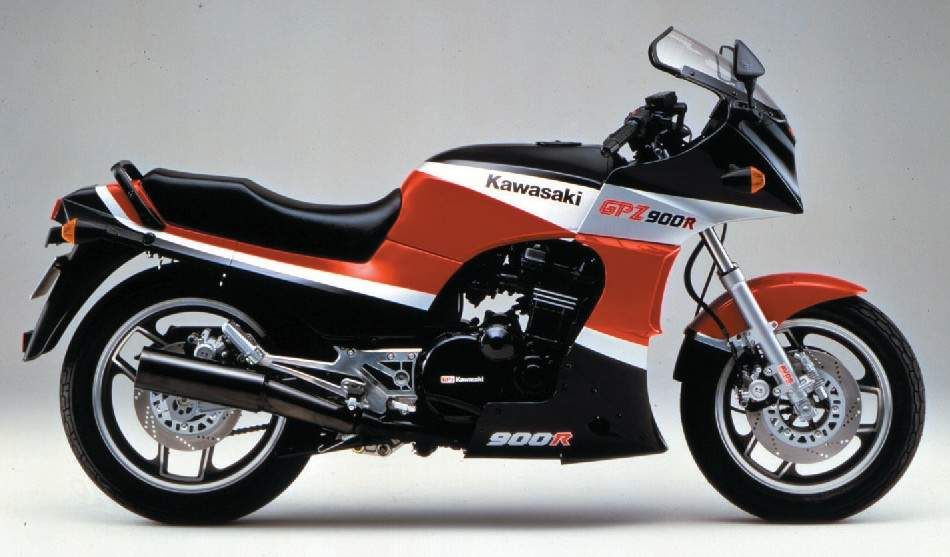
No list about the best Ninjas ever made would be complete without the bike that launched the name. In development for six years behind closed doors and in the highest levels of secrecy, the GPZ900R exploded into the sportbike world in 1984 and was so good that it was in production for 12 years, until 1996.
It was the first sportbike to have an engine with 16 valves, which helped the 908cc inline-four to produce 115 HP. A technical masterpiece, the engine also allowed the GPZ900R to break through another world first, being the first street production motorcycle to pass 150 MPH. Oh, and being the hero bike in a small movie called “Top Gun” also helped raise its profile.
11: 1988 Ninja ZX-10 “Tomcat”
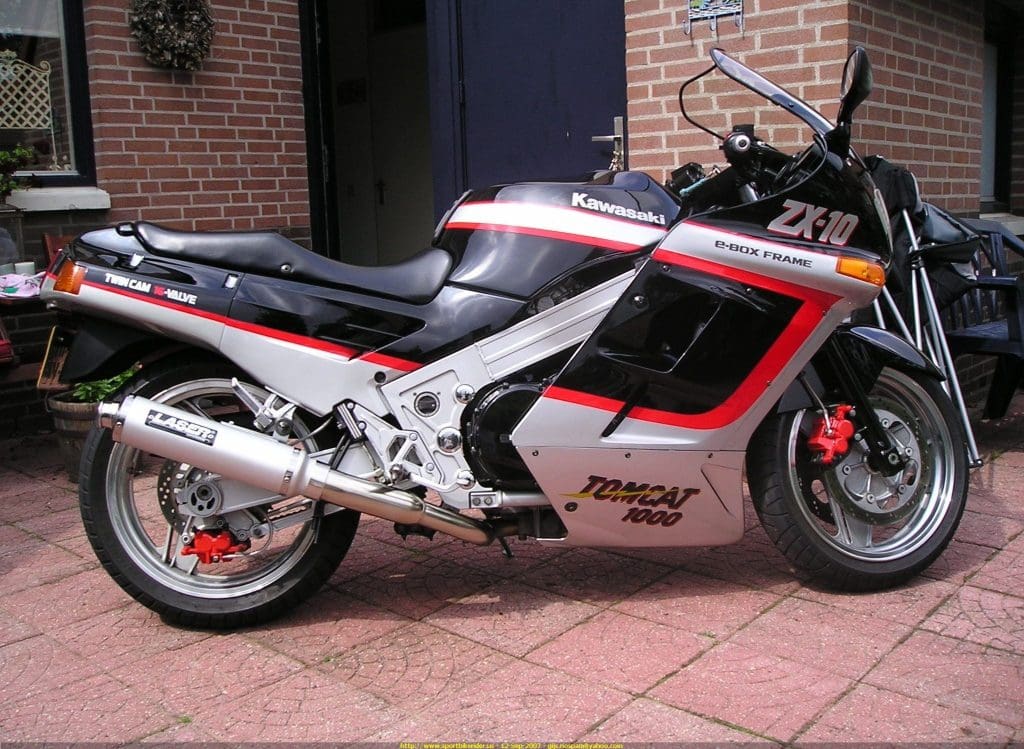
When the GPZ900R set and broke the record for the fastest street production bike, Kawasaki decided to maintain their record-breaking streak. In 1986, the Japanese brand released a follow-up machine, known as the GPZ1000RX. Building on the GPZ900R’s success, the new model soon claimed the fastest production motorcycle title. Though the newer model was intended to replace the GPZ900R, it didn’t. Instead, it hit the dealerships as a premium alternative to the already successful 900R.
In 1988, a differently designed 1,000cc bike replaced the 1000RX. For the first time, the famous ZX initials were used with the ZX-10. It brought forth quite a few technical firsts, such as the first aluminum perimeter frame; the first to use 36mm downdraft carburetors; and the first to break through 165 MPH. Production only lasted 2 years, until 1990, but the impact the model had on the sportbike world would reverberate through the 90s.
10: 1990-2002 Ninja ZX-11 ZZ-R1100
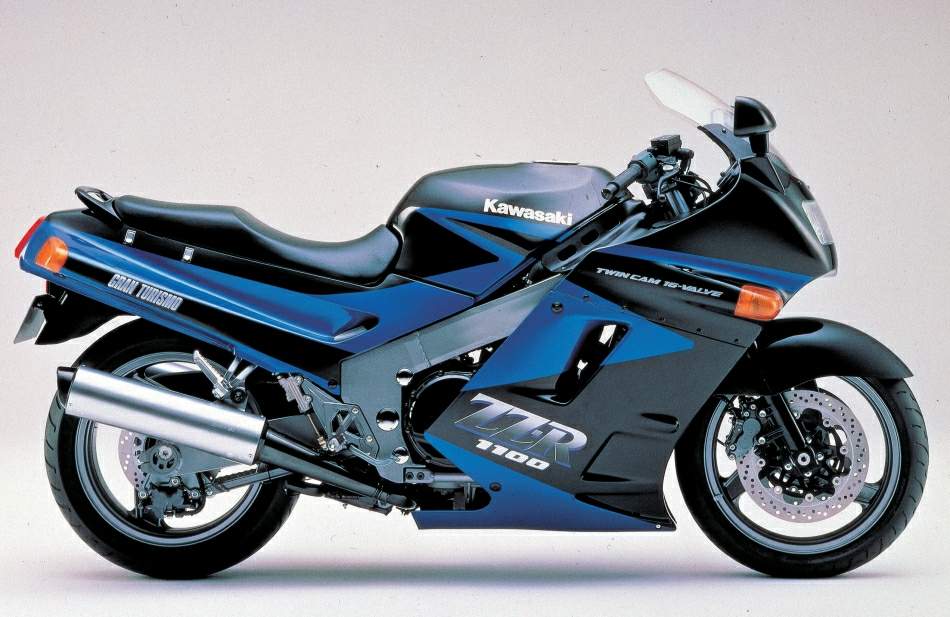
The follow-up model and the “final version” of what the ZX-10 Tomcat was meant to be, the ZX-11 ZZ-R1000, apart from having a long and redundant name, was a long-standing stalwart of the sportbike world. Using much of the same frame and design of the ZX-10, the ZX-11 added two key features that made it a monster.
The first of these was improved aerodynamics, as engineers were understanding more and more how the air flowing over the bike could be used to both stabilize the machine and improve handling and cooling. The second feature that made it a dominant monster was that it was the first sports production motorcycle to employ a ram-air induction system.
With a specially designed intake that sat below the headlight, under a certain speed the engine took the air in normally. However, once moving at a good clip, the air started to compress as it passed through the specially shaped intakes and thus allowed the engine to produce 134.5 HP and 79 lb-ft of torque at 8,000 RPM. This allowed for the ZX-11 to blast through the previous record top speed and hit 176 MPH.
9: 1995-2002 Ninja ZX-6R
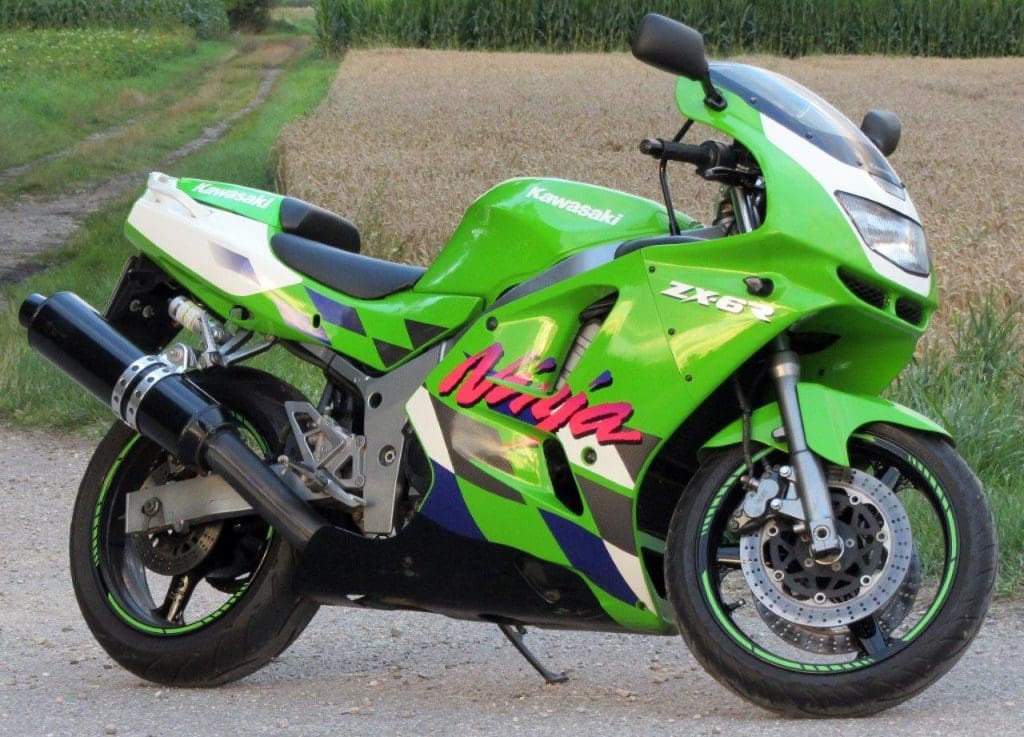
With Kawasaki seemingly the dominant force in the large displacement section of the sportbike segment, the other three manufacturers from Japan brought the fight to the now-legendary 600cc supersport class. Of course, Kawasaki had a 600cc motorcycle already in the ZX-6E, but it was designed as a much gentler sport touring motorcycle.
As such, Kawasaki responded to the announced plans of a new “junior” supersport segment by developing the 1995 ZX-6R. The original model had a smaller version of the ram-air intake that the ZX-11 had launched, but fed that air into a high-RPM inline-four that produced almost dead on 100 HP. A couple of evolutions in the late 90s with the G model ( bumping power to 108 HP) and J model (which boosted the compression ratio in the engine to better use the compressed rammed air, bringing the power to 112 HP) brought Kawasaki more inline with the competition.
However, to beat them, Kawasaki would have to create one of the most legendary 600cc supersport machines ever made.
8: 2006-Present Ninja ZX-14/ZX-14R
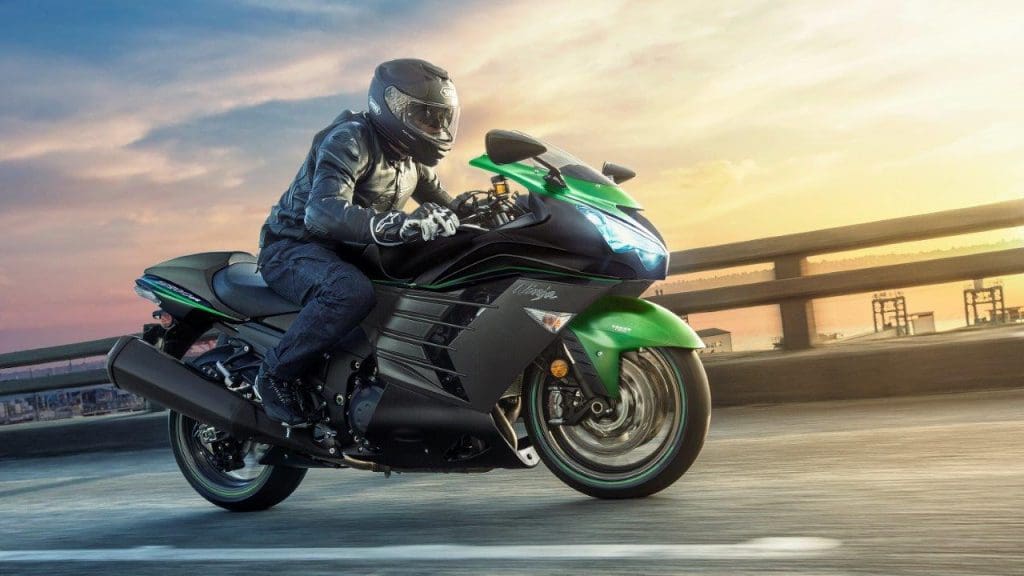
In the mid-2000s, there was an unofficial but very popular competition going on between the Big Four. Alternatively called either the “Power War” or the “Displacement War,” both titles describe the surge of bigger, more powerful, faster motorcycles, at times to the point of being ridiculous. Suzuki launched the whole affair with the 1999 Hayabusa or GSX1300R by its model code.
Kawasaki took their time to respond, but in 2005 the brand pulled the covers off of the year 2006 Ninja ZX-14 at the Tokyo Motor Show. It boasted a larger engine than the Hayabusa, faster acceleration, and it did not look like someone had sneezed and made a motorcycle. It was angular yet flowing, aggressive in all of the right ways, and could beat any competition in a game of top trumps.
What took the ZX-14 from being a great Ninja to one of the best of all time, however, was its ability to obliterate a drag strip, even in stock, showroom trim. 0 to 60 MPH was achieved in under 2.5 seconds. Though the top speed was limited to 186 MPH, with an ECU flash that restriction could easily be lifted. In stock trim, it could run the quarter-mile in just about 9.7 seconds.
And things only got better in 2011, when Kawasaki released the model refresh, upping the engine size, horsepower, and acceleration. They also appended the R to the end of the name, as it had also been trialed on the track, and had proven to be a capable–if somewhat heavy–track-day bike that could carve corners with the best of them. To this day, it is still the favorite for riders that like to consider the right wrist as a hyperspace lever from Star Wars, because everything goes from visible to a starry blur faster than the blink of an eye.
7: 2003-2007 Ninja ZX-6R 636 (aka ZX636)
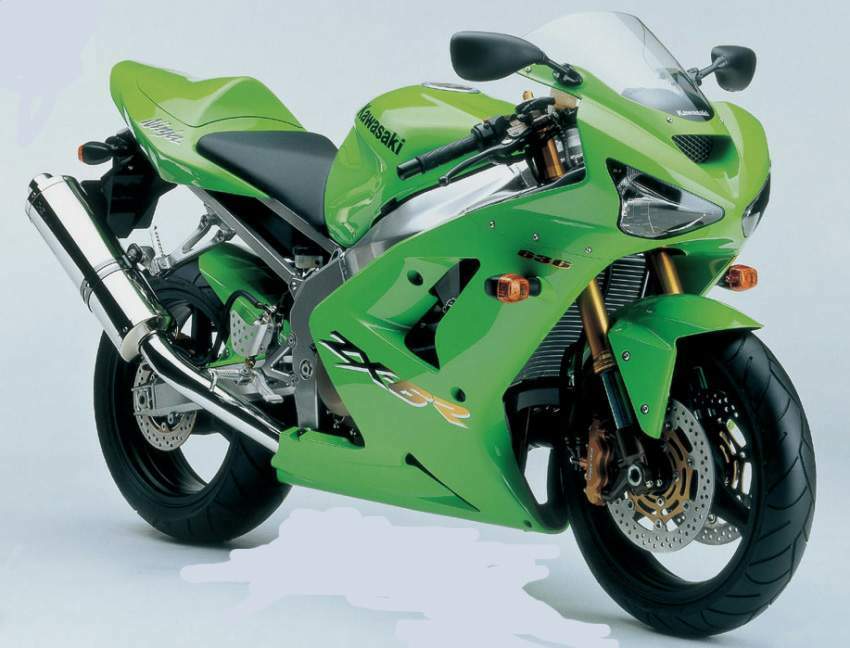
Kawasaki argued that the displacement bump was to make room for the injector heads, but it was a thinly veiled white lie that allowed them to boost power, response, and speed. This resulted in Kawasaki winning many of the magazine and TV show reviews of acceleration, handling, engine smoothness, the works. Honda, Yamaha, and Suzuki cried foul as Kawasaki had upset the “purity” of the 600cc class, yet Kawasaki simply put their fingers in their ears, hummed very loudly, and pointed at the “racing” version of the bike, the ZX-6RR, that still displaced 599cc’s.
6: 1988-2007 Ninja 250R
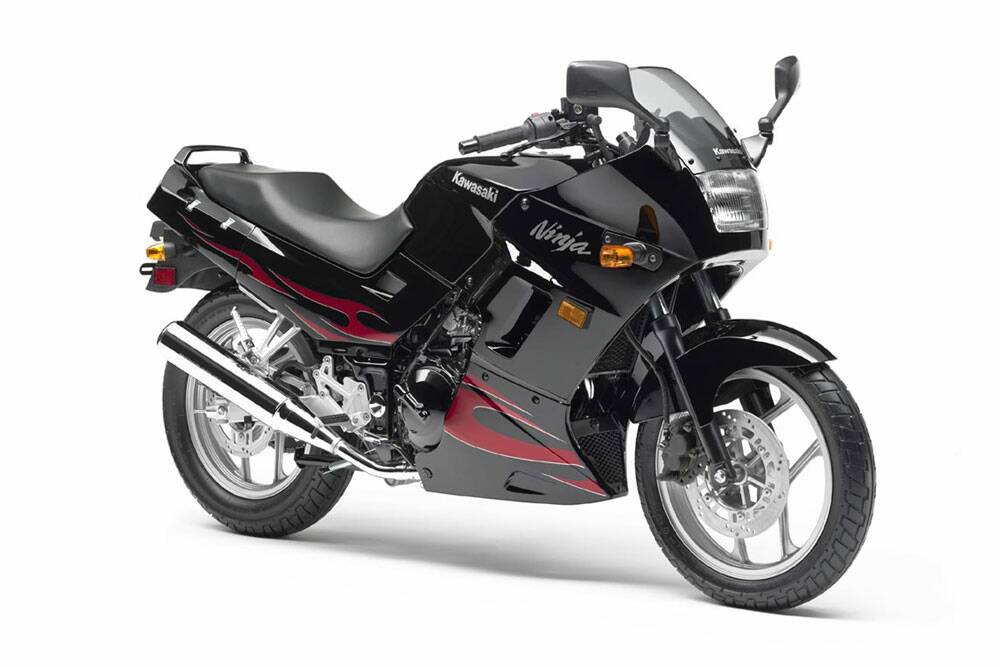
Known throughout its model life as the Ninja 250R, the EX250, or the GPX250R, this humble little parallel-twin engine motorcycle had a bit of a rough start to life. Originally released in Japan in 1983, and the rest of the world in 1986, the Ninja 250R engine suffered from bad compression, and the carburetors feeding it were too large. This made the bike great on fuel, but very slow to rev and accelerate.
In 1988, however, the model revamp that everyone wanted finally arrived. While the interior bore and stroke of the parallel-twin remained unchanged, the carburetors were made smaller, the compression was raised significantly, and the ignition timing was advanced to match these two changes. All of a sudden, a laborious, slow-revving engine became a screaming, 14,000 RPM powerhouse.
Changes to the suspension and the addition of three teeth to the rear sprocket also gave the agile little street weapon some serious acceleration. It also impressed in the handling department too, with the inherent balance of the parallel-twin slung way down low in the body allowing ridiculous lean angles in canyon carving outings.
The Ninja 250R was considered so good in its 1988 layout and specification that it only received a couple of minor cosmetic refreshes throughout its lifetime, lasting all the way up to 2007, when the last great carbureted small-displacement Ninja was silently shuffled off the order sheet and replaced with the fuel-injected Ninja 300
5: 2018-Present Ninja 400
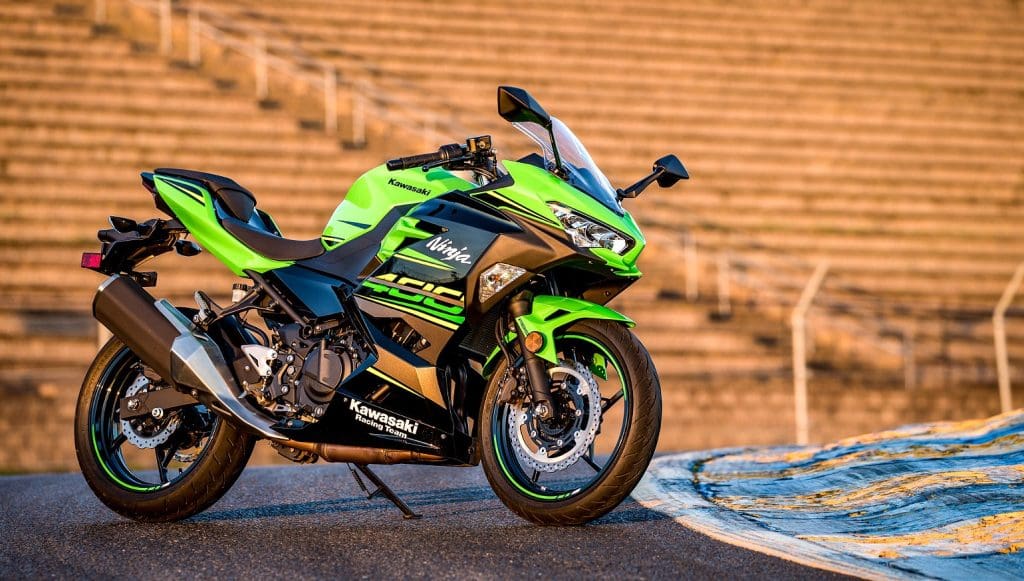
Thanks in part to Kawasaki’s dominance in World Superbike Racing, as well as being the best price-to-performance manufacturer from Japan, there has always been a market for a “cheap bike” that can do everything you need it to do, a few things you didn’t know it could do, and that was generally easy to operate and maintain. Starting with the Ninja 300 throughout most of the 2010s, 2018’s Ninja 400 is exactly that bike.
It is not designed to be the fastest, the first, or even be shown a track, although it is perfectly capable on one. What the Ninja 400 does is give new and experienced riders alike a motorcycle that follows the ideals of the original UJM bikes from the 1970s. This is, namely, being a motorcycle that is easy to ride, comfortable for long periods, with intuitive controls, a more standard riding position, and easy to maintain with accessible parts.
While there are other bikes out there that fill in the same needs, none do it quite as inexpensively as Kawasaki. This is not to say that the bike, or its manufacture, is “cheap” by any means, as the Ninja 400 and its predecessors have stood up to the test of time and miles with very few breakdowns entirely caused by wear. It has become a bit of a trope, however true or false, that if you have a lower displacement Kawasaki, you’ll either sell it or crash it before it breaks on you.
4: 2011-2015 Ninja ZX-10R
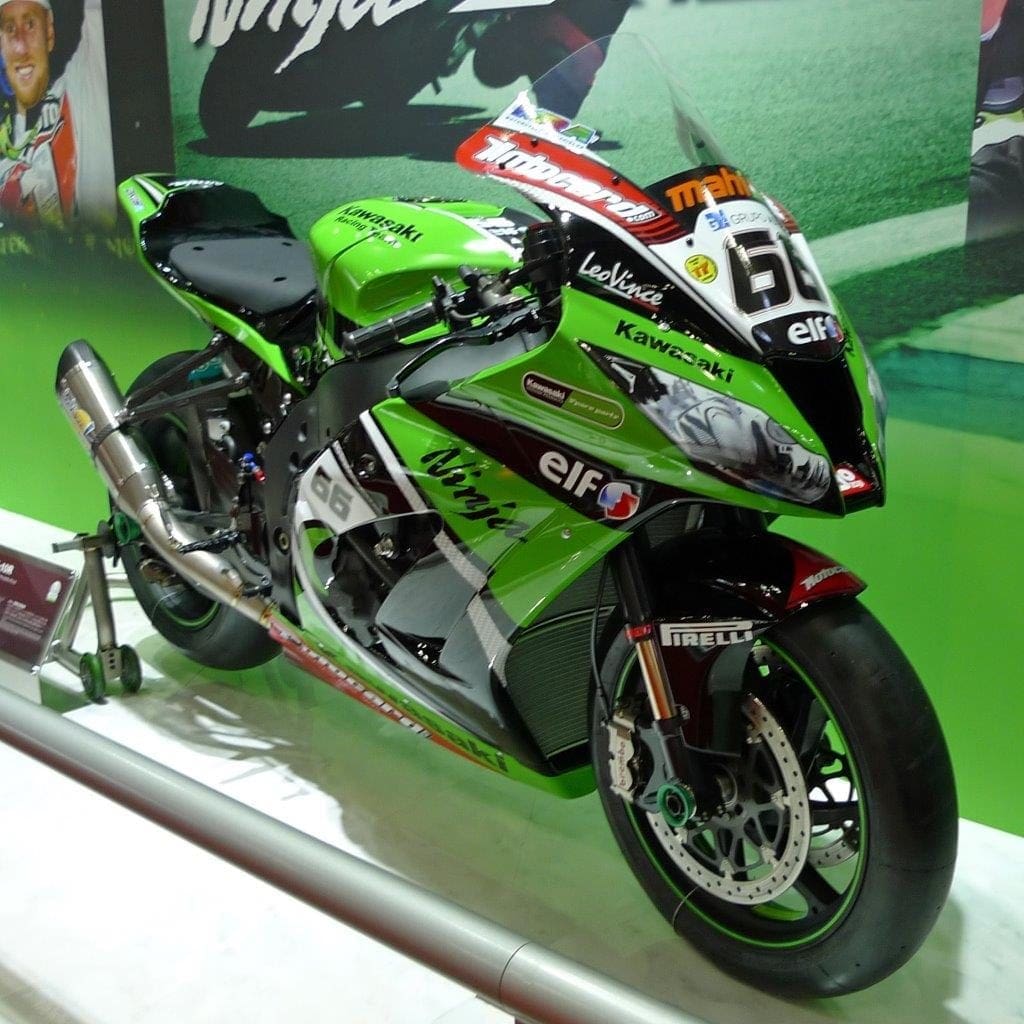
The championship-winning 2013 Kawasaki Ninja ZX-10R as ridden by Tom Sykes
In 2011, the Ninja ZX-10R, which had multiple previous variations from 2004 onwards, was completely taken back to the drawing board. What came out of the overhaul was a supersport that would define the early 2010s, and would dominate the World SuperBike Championship in racing trim.
The street version received updates across the board, including the introduction of intelligent traction control, intelligent ABS, a lighter-weight but still super-strong aluminum frame, adjustable footpegs, improved and larger throttle bodies for ram-air intake, Showa BPF front suspension, a horizontal, under-saddle rear suspension, and a full LCD TFT dash. It also included an Ohlins electronic front steering damper, to prevent death wobbles due to the power the bike was outputting, nearly 200 HP.
In 2013, Tom Sykes won the World SBK Championship on a ZX-10R in race trim, with Stuart Easton winning the 2014 Macau Grand Prix, one of the “must-win” races if you want your stock to rise in superbike racing. In 2015, Jonathan Rea won the 2015 World SBK Championship on a ZX-10R race supersport and has gone on to win a grand total of 6 titles so far, all on a Kawasaki.
3: 2006-Present Ninja 650R/650
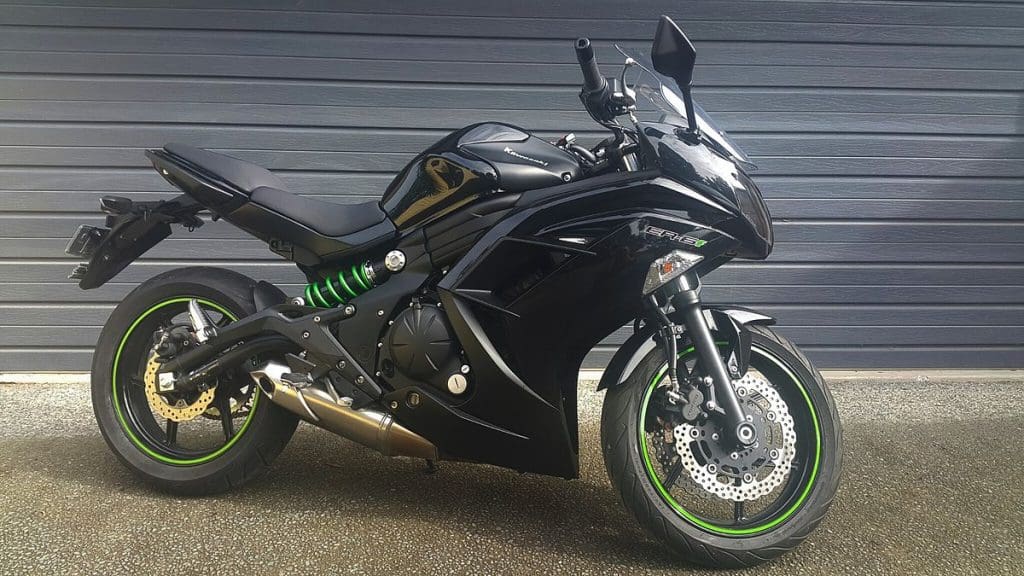
The Ninja 650R and 650 are here not because they are the latest and greatest in terms of sports technology, nor are they here because they were designed to smash the competition into itty bitty pieces. Why they are here, however, is because of the revolution that they helped to launch in the mid-2000s for people wanting to ride motorcycles.
For a while before 2006, if you wanted to learn to ride a motorcycle and have a good first bike, you either started out on a very low displacement machine, or you leaped headfirst into the 600cc and up supersport segment. There was no real middle ground, except with some European motorcycles that, because of tariffs at the time, cost an arm and a leg. Suzuki noticed it first around the turn of the millennium, with Kawasaki paying attention as well.
Those two manufacturers then brought out two of the most highly recommended beginner bikes: the SV650 and the Ninja 650R. Finally, beginner riders had bikes that could carry them comfortably at a low cruise, and then with a twist of the wrist, turn into corner-carving sportbikes.
With a model revamp in 2012, the Ninja dropped the R from its name and is now legendary for being one of the best price-to-performance bikes a new rider can buy new, and keep using even after they’ve learned to ride.
2a: 2015-Present Ninja H2R
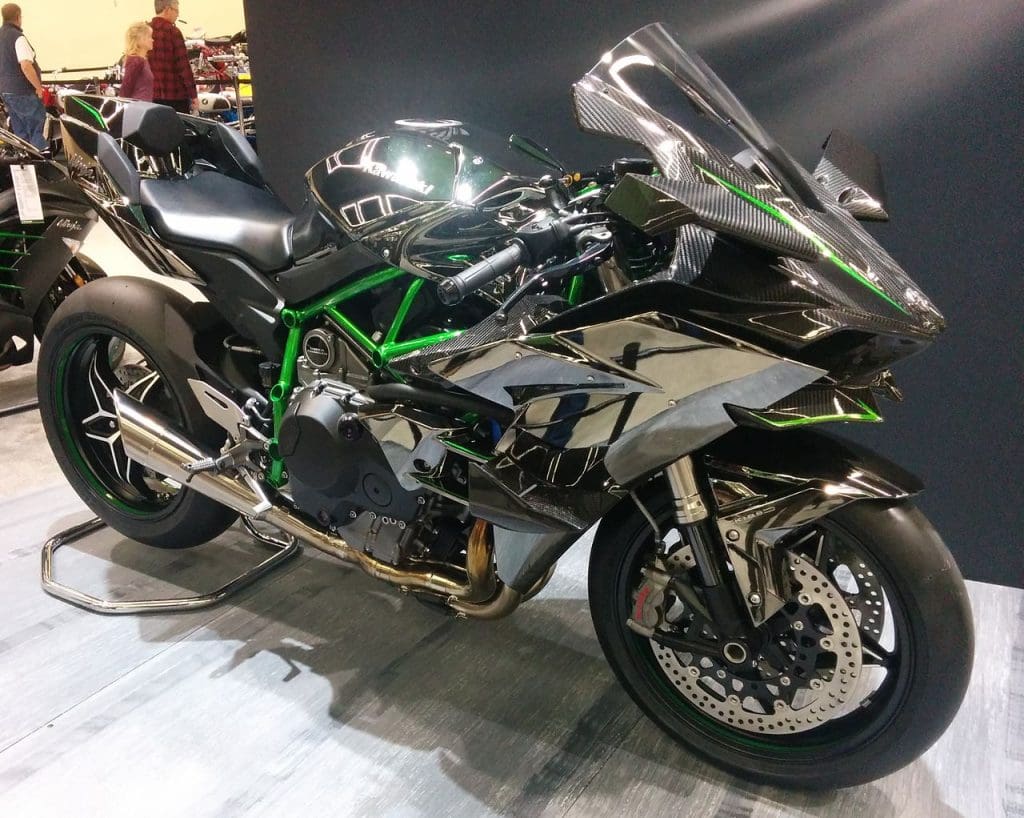
Always at the forefront of technology and development, there had been rumblings for years that Kawasaki had a supersport in development that would rattle the market. In 2015, Kawasaki unveiled the new Ninja H2R, and it not only rattled the supersport world, it created an entirely new class of sportbikes now known as the hyper sport.
A track-only bike, it was a technical tour-de-force that made everyone, not just Kawasaki’s Japanese competitors, sit up and pay attention. Using the 998cc inline-four from a ZX-10R, engineers and designers then slapped on a high-speed supercharger that spins so fast that the tips of its impeller blades hit nearly 1.5 times the speed of sound. This compressed-air then passes through an intercooler mounted below the radiator, then gets fed into the engine, producing a nominal 320 HP.
The H2R accelerates so hard, so brutally, and so in defiance of physics, that an entirely new set of stability, anti-wheelie, and traction control systems had to be developed. Even then, with the bike being made almost entirely out of carbon fiber, aerodynamic winglets had to be added to the front to keep the nose down at high speed.
For the moment, the H2R holds the world’s fastest production top speed record at just a hair under 250 MPH.
2b: 2018-Present Ninja H2 SX
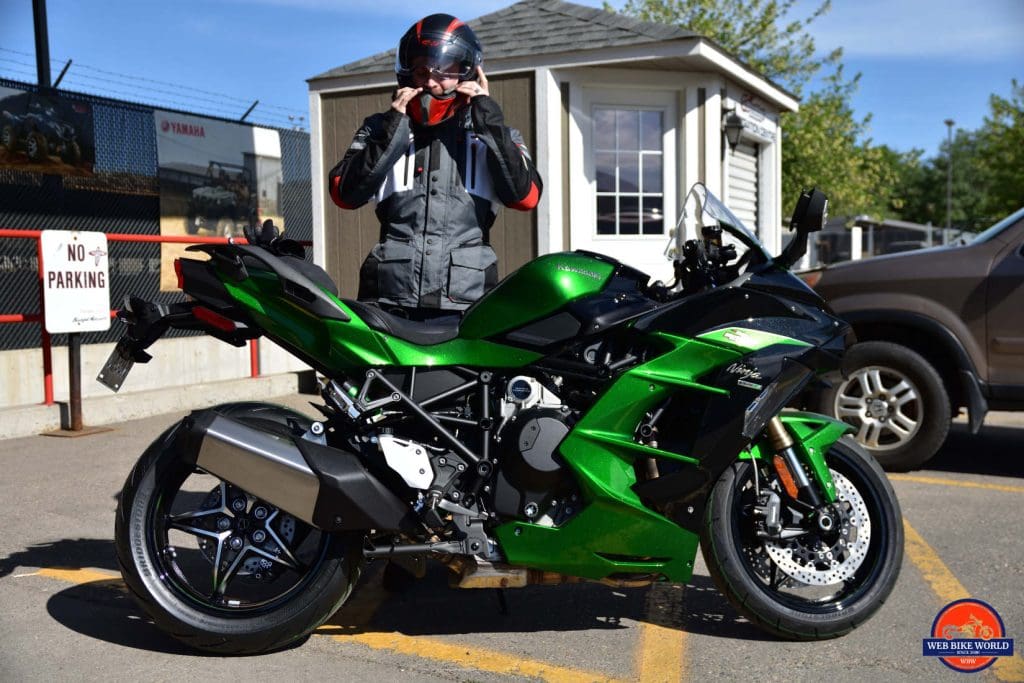
The 2015 Ninja H2R was always meant to be a limited series, a “this is what we can do” demonstration to the world that Kawasaki was at the top of their game. However, so much interest was raised from the release, as well as the customer demand for a road-going version, that the H2 program was morphed into Kawasaki’s top-tier lineup of motorcycles. There is the hypersport H2, the naked Z-H2, and then there is the most popular of the bunch, the sport-touring H2 SX.
Released in 2018, the H2 SX (H2 SX SE in some markets) was the ultimate expression of the sport-touring philosophy. Detuned from 320 HP to “only” 220 HP, the inline-four 998cc engine nonetheless had huge power all over the place, so you could drop a gear and pass a truck on the highway with ease, or if you came to a hill, just roll on a bit more throttle and feel the surge as the supercharger whacks air into the engine.
While it is by no means cheap, the H2 SX is the most realistic of the bikes to come from the H2 project. Kawasaki traction control, anti-wheelie, 6 axis ICU, cornering ABS, dual-zone linked ABS, mounting points for panniers, raised clip-ons for a comfortable riding position… the H2 SX has it all and more. Even better, once it’s at a highway cruise, it has an intelligent eco mode that turns it from a monster with infinite power into a quiet, comfortable, albeit slightly big sport-tourer that sips gas.
1: 2016-Present Ninja ZX-10R
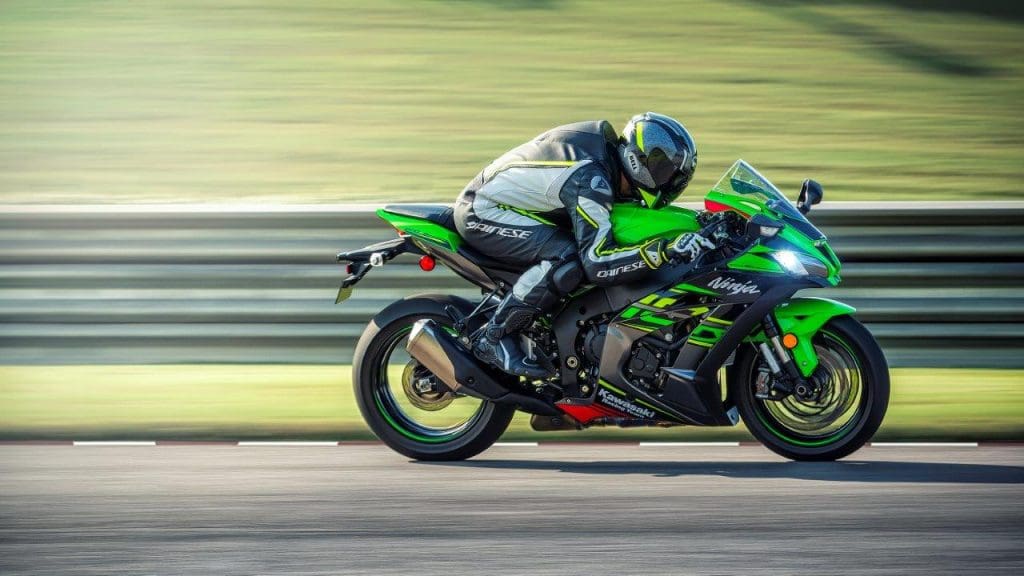
While many lists will put the technical powerhouse that is the H2R here, or the supersport for the masses, the ZX-6R here, for this list, the current generation ZX-10R is the clear winner. To qualify this choice, there are three major areas of importance that it fills out perfectly.
The first area is sales volume. Compare how many ZX-10R’s have moved from a showroom to the R1, the CBR1000RR, or the GSX-R1000R. It’s shocking, but the ZX-10R has outsold them all, even if you combine all three together for a given year. This falls mostly upon the fact that Kawasaki is still the price-to-performance leader from the Big Four, as well as that Kawasaki is dominant in World SBK. Racing tech trickles down to street-based supersports, and it shows with the tech that the ZX-10R packs.
The second area of importance that the ZX-10R fills is rideability. There is the thought amongst supersport riders that unless the bike is on a razor’s edge the whole time, it’s crap. Kawasaki thinks in the other direction. When it needs to be, it is a razor’s edge literbike, a canyon carving monster that screams over 13,000 RPM. But it also commutes comfortably, still has plenty of power down low, and doesn’t send as much force through the rider’s wrists as other supersports may. This is due to Kawasaki working hand in hand with Showa to make the front forks responsive and quick, but also soft enough to dampen out the bigger bumps.
The third area of importance is track performance. Any supersport rider will tell you that riding on the street and riding on the track are two entirely different things. While the Yamaha YZF-R1 may be considered the better all-around track bike and has tech trickle down from the M1R MotoGP bike, the ZX-10R is a direct brother to the World SBK ZX-10RR. You can quite literally take the street version ZX-10R, change out the brakes, the ECU, the shocks, and the wheels, and you have a bike that has won championships. So, of course, the ZX-10R is extremely handy around a track, and in the hands of a very good rider, can give even the vaunted R1 a run for its money.
In sum, it is basically the greatest street-legal supersport because it is the closest, by far, of any motorcycle to its top-class racing equivalent, is much less expensive than much of its competition, and is at the same time a comfortable commuter and a canyon-carving screamer.



No ZX7R, AMA superbike and WSB championships?
My sentiments, exactly!
No ZX9R from 1998? Ninja 250, 400, and 650??? And who in the world claims a new ZX10R is “comfortable”? Kind of a weird list. Sales numbers don’t determine “best Ninjas ever made”.
Where is my favorite, the ZX-7 and ZX-7RR. The RR model sure won its share of championships. If Kawasaki ever built a race bike for the street, this was it.
Agreed. The ZX-7R has to be on the list. No doubt. And I don’t see how the 2004-2005 ZX-10R isn’t on the list
Totally
The 2004 ninjas reinvigorated kawasaki after years of phoning it in.
The 2004 Zx10r is a classic already.
Yep, I had an ’05 and rode it for 10 yrs. Best bike I have ever owned as it was better than me at everything.
What about the 2000 ZX12R Unrestricted? The Ninja that took the Unrestricted Hayabusa down??
Zx9r all day long, excluding the B’s.
I don’t know whose opinion this was but y’all left out one of the best motorcycles Kawasaki ever made which is the 2000 ZX9R
Very true the zx9 was a great bike and this is coming from a Yamaha guy
Seriously? The 650? Clearly no clue about the whole thing lol!
Yeah I totally agree…loved my ZX7R…whew
As the former owner of a 1992 ZX-7, I was disappointed to not see the recognition that bike deserved.
That machine gave me feelings I’ve never felt since.
This article and many other articles like it have missed two main sportbikes in Kawasaki’s line up and were the proving grounds for Kawasaki technology. Ram air for one was first introduced on the ZX7R. And this bike took home many AMA motorcycle racing championships. More than any other Kawasaki to date. It was the first bike to introduce inverted showa forks as well. Kawasaki had a answer for the Hayabusa and it was not the zx14. It was the zx12 and the zx12r. It was produced for 5 years and had 3 iterations it was bike that made them sit down and have a gentleman’s agreement of 186mph. And it was the bike which the zx14 was born from. It introduced radial brakes, monocoque aluminum frame, with Integrated airbox. Centralized fuel cell and a list of other carry over tech into the zx14. And the 14 still builds of that to this day. So I’m gonna need yall to get the story right. And one more mention is the GPZ750 TURBO. How can we forget about that.
1993 Zxr750 homologation special.
Zxr400 1989
Zx7r 1996.
zx7r zx12r
What about ZX12R???
They left out the king 2000 zx12r
I owned a 2003 ZX6rr racing version of the Ninja. Let me tell you…0-60 in 2.5 seconds in first gear..120 in 5 seconds in second gear. I was reached 255 mph at 11000 rpm before the digital speedo flashed and went blank. I could’ve went faster but the forks started to wobble..the most insane rush of adrenaline i have ever experienced from a bike
255mph on a 2003 600cc? Have another round friend, and edit your post once you sober up…
My 04 636 would do 181 mph topped out in sixth. 0 to 60 in 2.9 seconds and the quarter in 10.4 seconds at 133 mph. With a full Yoshimura tri oval exhaust power commander USB 3 k and n air filter and dropped one tooth on the front sprocket.
Just a suggestion to the writer. You might double check the dates on the Ninja 250 – 300 change. The 250 ran until 2012.
love my bike I love how to rise love everything about it call sake could never have done any better than they had done and bring out the performance levels at this year make model kudos to Kawasaki keep up the good work
Terrible review. No ZX7 with the best front end in the business, and more surprisingly no ZX12. Who writes this drivel?
Youz forgot the best one of all, ZX12R, it was the 600/liter bike/hyper bike/tour’e for man sized men?…
The st is pretty accurate but it’s ruined by the fact that you didn’t include the ZX-7R. How you forgot to include it is beyond comprehension…
I have had kawasaki all my life from dirt bikes growing up to LTD 1000, fell in love with zx11 never thought there be better bike until 2007 white special edition ZX14 stole my heart ❤ now with 53,000 miles I still to this day get compliments on how beautiful the bike is
I absolutely loved my 2009 ZX14 that I set up for sport touring and had a great time riding it until the cam chain tensioner failed at a stop light and sounded like I dropped the silverware tray down the garbage disposal and had 88,000 miles on it and my favorite bike ever finally exceeding my lust for my former best of all time 1979 Suzuki GS 1000E both fantastic rides but I was totally addicted to those quick bursts of pavement inhaling and would hit 110 every other day briefly on the way home from work and I never got any tickets or pulled over in it
So wrong.
The H2 series are #1.
Where’s the ZX-7R? I have a 2000 with over 50,000 miles and runs like a champ. WSB championships and ran with the 1000cc bikes for a year.
Zz top
I own a ninja z1400
Now discontinued due to emissions
I have owned a 2006 ZX14 for 11 years it was an incredible bike, we changed a few things to make it better and faster. But now I have a 2013 ZX14R the newer ZX14Rs are a much better bike , and we changed the things on it to . It is so incredibly fast , this is by far the best bike I’ve ridin and owned.
Why do you leave out the zx12r, that was a bike that murdered the drag strip, and wrote calligraphy in the Twisties, how dare you leave this bike out of the list, why would you skip the most versatile weapon Kawasaki had. Yes, the 14 is super duper stupid fast, but can’t handle for ish, the 11 was quick too but again, no handle, the 12 was like a 600 that can dance on any floor you put it on …
I had several Triples & they were to say “Rice Rockets”. I started with the 350 & up to the 750. Each one was better then the last. Off the stop line in town with the least bit of throttle was always the front end up & in the air & your leaning into it & it just didn’t get in contact with the asphalt unless you came off the throttle. It didn’t take much throttle to get the front end up. The power curve was insane & quick & you weren’t really into the throttle that much. It was a real rush to ride these bikes!!! Best cycles built!!!!